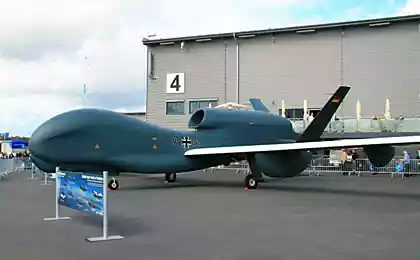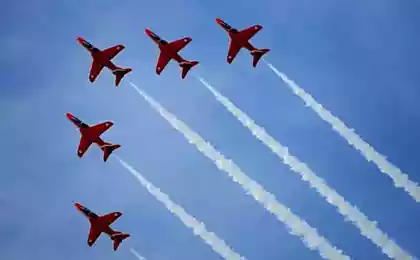1621
RQ-4 Global Hawk (photo)
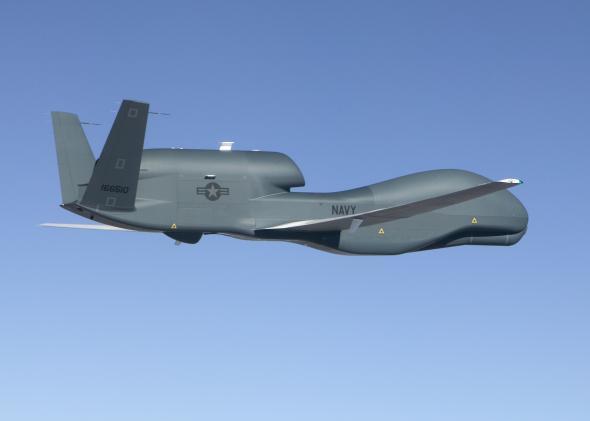
Program Tier - a project to build high-altitude long-range reconnaissance UAV able to get information on any point on the globe, at any time, regardless of weather conditions. According to the terms of reference UAV Tier II Plus should conduct continuous reconnaissance at high altitude. It should have a range of over 5,500 km and have the ability to patrol over the area of exploration for more than 24 hours at an altitude of 18,300 m. For reconnaissance must be equipped with a synthetic aperture radar (synthetic aperture radar (SAR), electro-optical and infrared camera High resolution. It should also have the ability to simultaneously use this equipment. From the communication channels should have a broadband satellite link and the link within the visible area.
The cost of UAVs should not exceed $ 10 million. In the financial year 1994 prices.
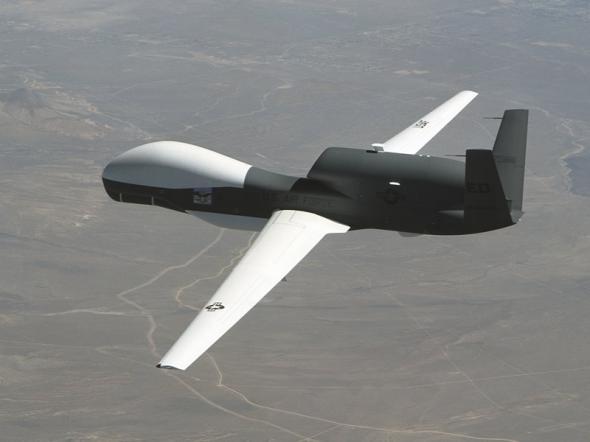
The project company Teledyne Ryan Aeronautical (TRA) UAV RQ-4A Global Hawk in May 1995, was selected the winner in the competition for the best for the UAV program Tier II +. The contest lasted for 6 months, it was attended by five firms - applicants.
The company Teledyne Ryan won the contest is not accidental. She is one of the first in the United States engaged in the development of UAVs. Her long high-altitude reconnaissance UAVs have proven themselves during the Vietnam War.

UAVs AQM-34 is based on the target BQM-34A Firebee
Global Hawk UAV capabilities have aroused great interest not only from the US military, and the military in Australia, Britain, Israel and Saudi Arabia. It offers great prospects for the company Teledyne Ryan, which has many other ideas on the use of the "King of the UAV": for example, it can be used as a repeater, as a high-altitude research laboratory or as a carrier of anti-missile weapons to counter ballistic missiles.
The first flight 02.28.1998 Global Hawk made a US Air Force Base Edwards, California. Take off at the speed of 200 km / h from runway 08, the flight lasted 56 minutes at a speed of 280 km / h. It reached a height of 9750 meters. Due to the fact that the chassis is not fixed securely in the retracted position and the instrument compartment temperature sensors showed too low temperature, testers decided to lower altitude to 6,100 meters and reduce the duration of the flight. After transmitting the commands to the UAV landing on a runway 22 at a speed reduced to 0.7 m / s. For braking on the runway in addition to conventional brakes brake pads are used. Mileage up to 1200 meters. Through the use of differential navigation system GPS, the deviation from the runway after landing was less than 50 cm.
Since testing began. By the end of the second phase was planned to make 15 flights for a total of 250 hours. For this purpose, based in San Diego has been collected a second UAV Global Hawk. It was equipped with a full complement of on-board equipment, including intelligence. First flew on 20.11.1998.
RQ-4 made by the normal aerodynamic scheme with low high aspect ratio wing. Wing, manufacturing concern Boeing, made entirely of composite material based on carbon. It is possible to create a thin wing with elongation 25. On the wing there are at least two points of the external suspension, designed for loads up to 450 kg each. Three-point chassis with nose wheel. On the nose landing gear has one wheel on underwing racks - on two wheels. Semi-monocoque fuselage manufactured by Teledyne Ryan aluminum alloy. It consists of three main parts. In front is the instrument compartment. There, under a large radome is a parabolic satellite dish diameter of 1.22 meters. In the same compartment is placed all the intelligence apparatus. In the middle part there is a large fuel tank and tail section is the jet turbofan engine Allison AE 3007H. The engine is borrowed almost unchanged from the aircraft business - class Citation-X and EMB-145. After making small changes to the engine management system consistently operates at altitudes up to 21,300 meters.
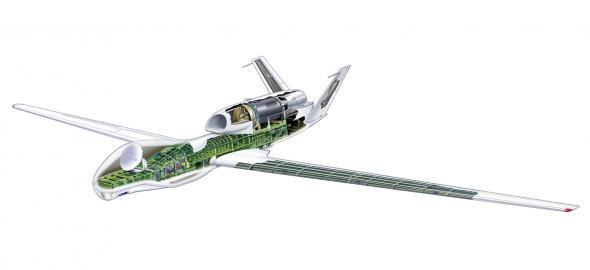
Layout scheme RQ-4 Global Hawk
V-shaped tail unit, manufactured by Aurora Flight Sciences, also made of composite materials.
UAV itself is a platform for various intelligence equipment. On the Global Hawk set three subsystems intelligence apparatus at the same time. They operate at different wavelengths, can operate simultaneously and are distinguished from each other as follows:
Synthetic aperture radar manufactured by Raytheon (Hughes) and is designed to work in all weather conditions. In normal operation it provides a radar image area with a resolution of 1 meter. During the day, the image may be obtained from an area of 138 000 km2 at a distance of 200 km. In point mode («spotlight» mode), recording area of 2 x 2 km for 24 hours can be obtained more than 1,900 images with a resolution of 0, 3 m. In the third mode (X-Band) radar can follow a moving target if it the rate of more than 7 km / h.
Two radar antenna (located on the sides at the bottom of the instrument compartment of the fuselage length of 1.21 m) and the necessary electronic equipment weighing 290 kg potreblinyut 6 kW of electricity.
Daily electro-optical digital camera manufactured by Hughes and provides high-resolution images. The sensor (1024 x 1, 024 pixels) is associated with a telephoto lens with a focal length of 1750 mm. Depending on the program, there are two modes of operation. The first - the scan width of 10 km. The second - a detailed view of the area of 2 x 2 km. For nighttime images using the infrared sensor (640 x 480 pixels). He uses the same telephoto. The lens can be rotated at an angle of 80 degrees.
Radar daytime and infrared cameras can be operated simultaneously to provide a wealth of information. Day / infrared camera has velocity information issuance - 40 million. Pixels per second, which is depending on the color resolution of 400 Mbit / sec. On-board system for the collection and storage of information received compresses digital images and records them.
For transmission of information to consumers can be reused multiple communication channels. On the satellite channel data transmission rate of 50 Mbit / s. For these purposes the satellite communication system Ku-band (SATCOM), antenna diameter of 1.22 meters. In the direct channel UHF band can transmit information at speeds of 137 Mbit / s.
The information is sent to a ground station and mission control to the control station takeoff / landing. In the future, users do not have a connection with the ground station will be able to receive images directly from the drone Global Hawk.

To find out more, but unfortunately less quality scheme RQ-4
Global Hawk will be integrated into the existing system of tactical air reconnaissance (flight planning, data processing, exploitation and dissemination of information). If it is connected to such systems as a unified system of providing intelligence (JDISS) and Global Command and Control System (GCCS), the image will be transferred to the operational commander for immediate use. Data obtained from the UAV will be used for detection purposes, for planning strike operations for reconnaissance, as well as to solve other problems.
If the Global Hawk will act in the interests of the US Army, the processing of the images to be produced Enhanced Tactical Radar Correlator (ETRAC) and Modernized Imagery Exploitation System (MIES) (or their successors). If the interests of the US Air Force, with the help Contingency Airborne Reconnaissance System (CARS); if in the interest of the Navy and the USMC - Joint Services Imagery Processing System-Navy (JSIPS-N). Common ground station (Common Ground Station (CGS)) can work with images to process any of these systems.
The program requires that the UAV without using stealth technology had sufficiently high survival rate. For self-defense Global Hawk is equipped with radiation detector radar AN / ALR 89 RWR and the jammers. If necessary, he can use a towed jammer ALE-50. Experiments on modeling of real-life situations have shown that the Global Hawk can perform more than 200 flights without damage if the route of the flight planned in view of the current situation (outside the zone of active combat operations). In case of danger, the UAV can call for help by contacting the nearest patrol aircraft or aircraft AWACS.
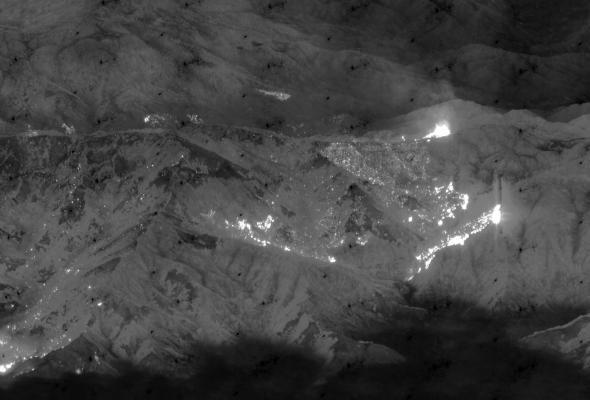
Pictures forest fires in Kalifirnii made aboard RQ-4
To improve the mobility of all ground equipment placed in containers or on special trailers. The composition of ground equipment includes:
The control station takeoff / landing
Station flight operations management
Trailer from the antenna equipment (SATCOM)
Home satellite
Trailer cables
Two generators
Two additional generator
Set the power equipment
Engine stand with engine
Kit parts
Maintenance Kit UAV
Station flight control and management station takeoff / landing are placed in separate containers the size and 2.4h2.4h7.2m 2.4h2.4h3.25m respectively. For the convenience of moving the containers are equipped with retractable wheels. The complex ground equipment UAV Global Hawk can be transported by air in three military transport aircraft C-141B, and two C-17 and one C-5B.
March 29, 1999 at 10:14 UAV Global Hawk2 during a test flight lost control and crashed near the lake Searles Lake. It happened at an altitude of 12,500 meters after a signal to stop the flight from the air base Nellis, Nevada. UAVs began implementation of a programmed maneuver flight termination and fell into a tailspin. The accident slowed down the program for at least two months. Making a replacement for the crashed UAV will cost $ 30 million. From 1994 to March 1999, the Global Hawk program has already invested $ 280 million.
December 6, 1999 after successful completion of the flight and landing at the US Air Force Air Force Base Edwards, California incident occurred UAV Global Hawk3. During taxiing on the runway main airbase at the turn of the wheel burst on the nose landing gear. UAV has not received any damage.
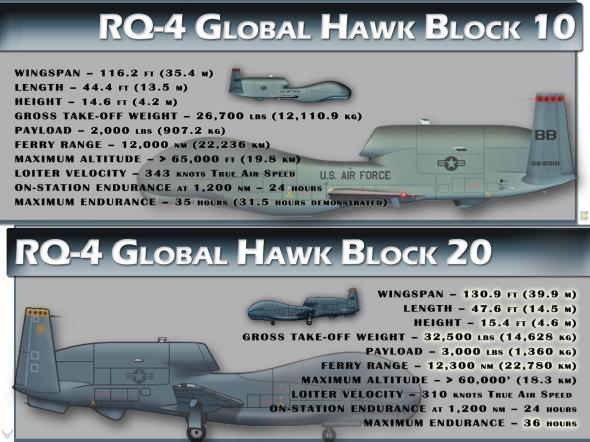
Modifications and characteristics of RQ-4
June 25, 2009 the corporation Northrop Grumman and the US Air Force introduced the first UAV RQ-4 Block 40 Global Hawk, equipped with radar system MP-RTIP (Multi-Platform Radar Technology Insertion Program). According to the developers, UAV different improvement in performance, and mounted thereon radars provide "unprecedented" opportunities detection and tracking of air and ground targets.
Presented drone Global Hawk was the 27th of its kind, built since the program began in 1995, and the first UAV to modify Block 40. His trial, as reported by the representative of the manufacturer, to begin in July 2009, although the total flight UAV such as Global Hawk has already exceeded 31,000 hours. In the future, in the Grand Forks air base US Air Force in North Dakota planned to supply 15 similar unmanned aerial vehicles in the version Block 40.
Northrop Grumman claims that he is able to rise to a height of more than 18 thousand meters and stay in the air more than 32 hours. The maximum speed of the drone reaches 630 kilometers per hour. The newest radar system MP-RTIP, which is used in the design of the machine allows to monitor ground and air targets at any time of the day, regardless of weather conditions.
Radar System MP-RTIP, which is developed by Northrop Grumman Corporation from 2000, in the long term is to improve the possibility of American air detection and tracking of cruise missiles. In addition to the drone Global Hawk, it was planned to establish a multi-purpose aircraft to the US E-10 MC2A, but the project was closed. Instead, they plan to re-equip old reconnaissance aircraft E-8 JointSTARS.
About combat application Global Hawk does not know much.
The first two series of UAV RQ-4 Global Hawk Block.10 were applied over Iraq in early 2006. According to the company Ryan, total plaque three Global Hawk on 01.04.08 used during combat operations in the Middle East in the "war on terror", has made 21 thousand. Hours, deposits with combat missions - 17, 5 thousand. H. The effectiveness of combat employment was 95%.
RQ-4 is used by the 53rd Wing. Eglin, Florida
